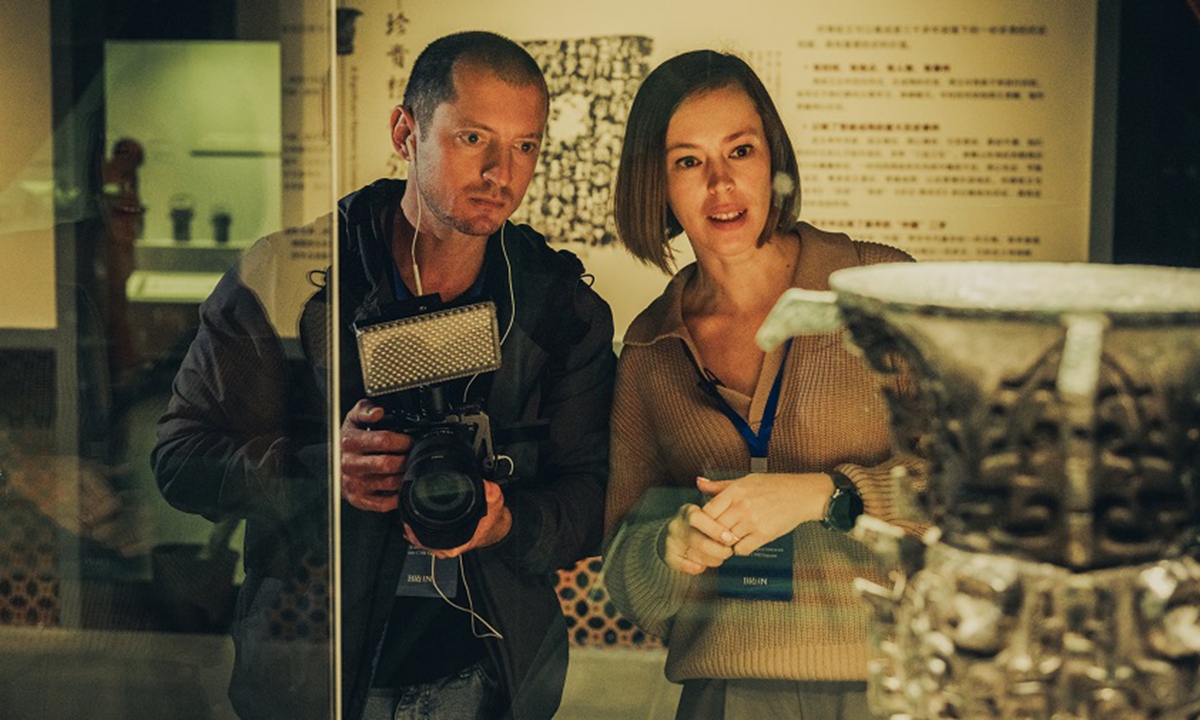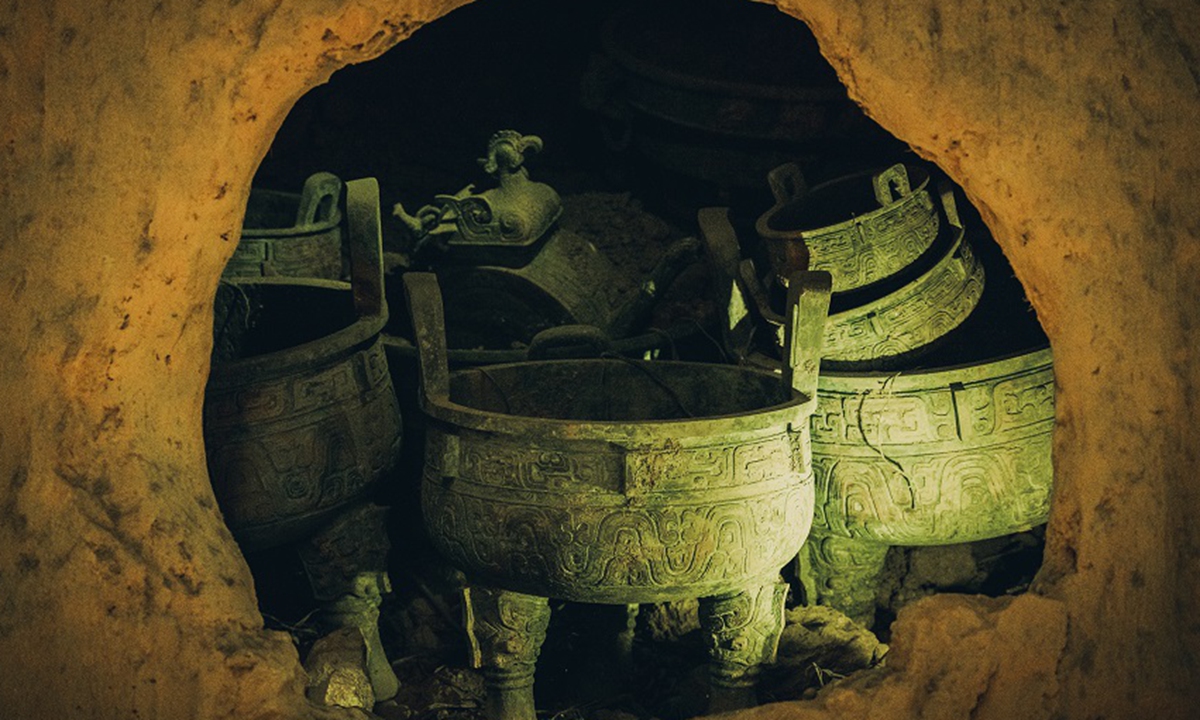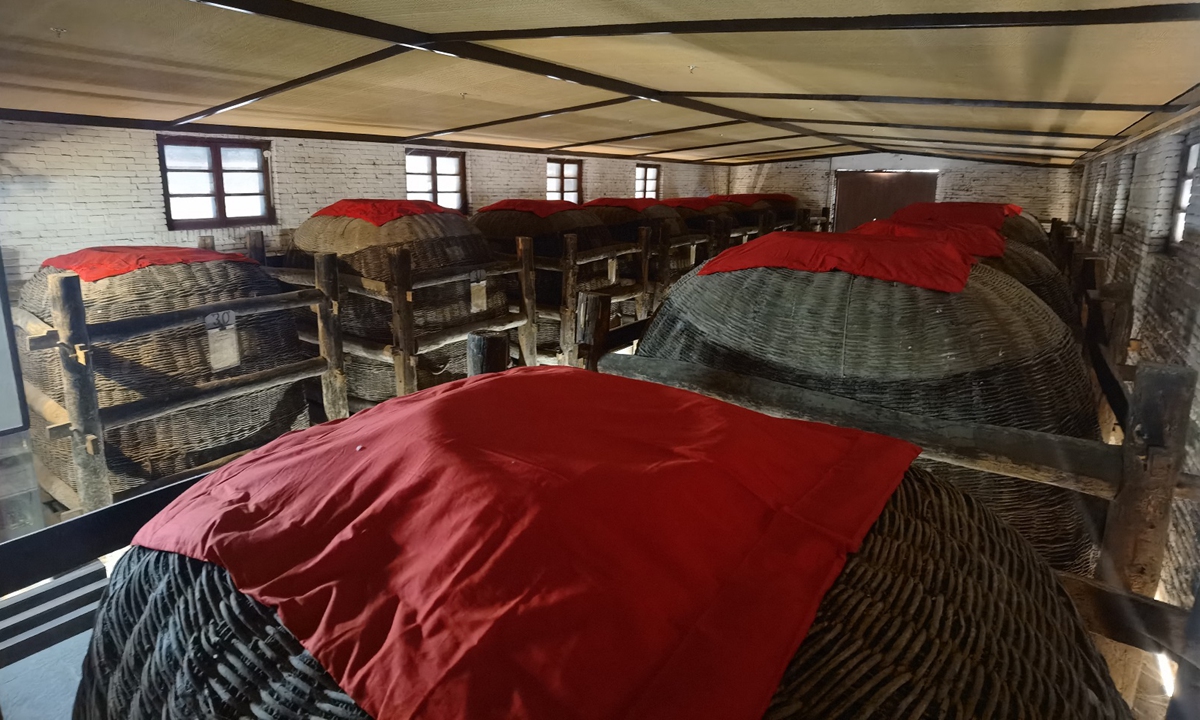
Members of the delegation examine bronze ware artifact on October 13 at the Baoji Bronze Ware Museum in Baoji, Shaanxi Province. Photo: Courtesy of Zhu Junqiang
Although it is not as famous as Xi'an, the capital city of 13 dynasties in ancient China, the city of Baoji in Northwest China's Shaanxi Province also contains the ancient splendor connected to the Silk Road. While Xi'an is considered the starting point of the ancient Silk Road, Baoji boasts some cultural relics that show the continuity of Chinese civilization.
Last week, a delegation of media representatives from 10 Belt and Road countries visited Baoji to experience the city's glorious history.
Passed down from ancient timesThe Baoji Bronze Ware Museum is home to a vast collection of bronze artifacts, including a variety of ancient drinking vessels which reflect the rich drinking culture of ancient China.
"Discovered by chance in 1963 by a local farmer, with a 122-word inscription on its base, the He Zun was found to bear the first written form of the name zhongguo (China). It is among China's 64 national treasures never to be exhibited abroad." As the delegation listened to the translation of the story behind the valuable artifacts as shared by a museum guide, they were eager to have a closer look at the piece and take photos.
Dating to the Western Zhou Dynasty (1046BC-771BC), the He Zun, a ritual wine vessel, was usually placed in the temple and was mostly used for sacrificial ceremonies. The expression zhongguo was used in its inscription for the first time in recorded Chinese history, which further confirmed that the ancient Chinese were already calling their country "China" more than 3,000 years ago.
The Chinese civilization is the only uninterrupted civilization in the world. If one does not learn about China from the continuity of its long history, there is no way for one to understand ancient China, modern-day China, or China in the future.
Serik Korzhumbayev, editor in chief of DK News Agency in Kazakhstan, who has visited China several times, said he found the opportunity to learn about the continuity of the Chinese civilization very intriguing and fulfilling. "I hope more people from my country will come to visit the museum to learn about the rich history of China."
Aside from the He Zun, the Baoji Bronze Ware Museum's collections also include a variety of ancient drinking vessels which reflect the vibrant drinking culture of ancient China that was often intertwined with its social, religious and political life. The types of vessels used for drinking weren't merely functional but are also deeply symbolic and artistically crafted, serving as reflections of China's rich cultural and artistic heritage.
Aygun Hasanova, editor in chief of the Azerbaijan State News Agency, was impressed by the vast collections of Chinese cultural relics, all of which are under excellent protection.
"Only when you study history well will it lead you in the right direction toward a better future," commented Hasanova.

Bronze ware artifact on display at the Baoji Bronze Ware Museum. Photo: Courtesy of Zhu Junqiang
Time-honored heritageThe exploration of Chinese drinking history and culture continued at the factory of Xifeng Liquor, a local time-honored Chinese
baijiu brand. Its ancient fermentation and storage techniques were included in an extended representative list of State-level intangible cultural heritage items released in 2021.
According to the China Alcoholic Drinks Association, Chinese
baijiu ranks among the top six distilled spirits in the world alongside brandy, whisky, vodka, rum and gin. The spirit, however, adopts natural, multi-strain solid-state fermentation and distillation, a departure from the traditional concept of distilled spirits in the West.
As one of the quintessential elements of Chinese culture, the brewing of
baijiu enjoys a long history dating back to ancient times.
Stepping into the cellar, a row of large Jiuhai immediately captured the visitors' attention. Jiuhai, which can be literally translated as the sea of liquor, refers to the unique storage container used in the
baijiu brewing process, which can hold a large volume of the liquor. Dubbed the living fossil of Chinese
baijiu history, the storage method has been passed down through the centuries from ancient times in China, offering a practical way to store liquor by using locally sourced materials.
The Jiuhai at Xifeng were made from reeds harvested from the deep mountains of Qinling, with tofu used to fill the vessels' crevices. After undergoing a natural drying process, the vessels would then be layered with hemp paper and white cotton cloth coated with a natural "glue" made from materials such as egg whites, with 100 layers of paper pasted, and finally sealed with beeswax and cooked rapeseed oil, introduced Lu Shaojun from Xifeng Liquor to the delegation, pointing to the ancient Jiuhai at the factory.
Some of the Jiuhai at the factory could be traced back to the Qing Dynasty (1644-1911) and 12 of them were registered as national cultural relics.
"The process from cutting reeds to completing the Jiuhai and filling it with
baijiu takes more than half a year. Thanks to the exquisite craftsmanship of the artisans, such containers hold liquor without spillage, and yet leaks when filled with water. This is the great wisdom of the ancient Chinese people," said Lu.

Jiuhai at the Xifeng Liquor's factory Photo: Courtesy of Lu Shaojun
Outstanding traditional culture is the root of the heritage and development of a country and a nation. During the tour, Alexandru Tanas, president of Moldova's News Agency Infotag, took notes. He was moved by China's excellent protection and passing down of the country's cultural heritage and traditional culture.
"Wine production is a pillar industry in Moldova. Both our white and red wines are excellent. Chinese
baijiu is entirely different, yet it has its own kind of beauty. It's very interesting. I cannot wait to share all my experiences about
baijiu, as well as China's long history of liquor-making and drinking culture to people in Moldova," he said.
Zhang Qian, a royal envoy of the Western Han Dynasty (206BC-AD25), began his journey to the Western regions via Central Asia with his entourages, an expedition which led to the opening of the Silk Road.
"We believe he brought
baijiu with him to convey friendship and peace and took wines back with him, introducing wine to China. Such cultural exchanges and friendship along the Silk Road continue today," Lu concluded the tour, raising a small vessel with
baijiu to toast to the continuity of ancient traditions and culture.






